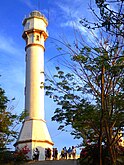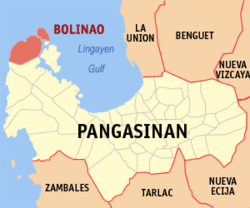|
Bolinao
Bolinao, officially the Municipality of Bolinao (Bolinao: Babali nin Bolinao; Pangasinan: Baley na Bolinao; Ilocano: Ili ti Bolinao; Tagalog: Bayan ng Bolinao), is a municipality in the province of Pangasinan, Philippines. According to the 2020 census, it has a population of 83,979 people.[3] Sea urchins are regularly harvested at Isla Silaki, Bolinao.[5] The town, aside from being a fishing domain, is also a heritage site in the Philippines, possessing an olden church surrounded by heritage houses. The town is also the location of the cave where the gold-teeth Bolinao Skulls with fish scale designs were found. Scholars have been pushing for the addition of the town's cultural landscape into the UNESCO World Heritage List. EtymologyFolk etymology attributes the name "Bolinao", a remote fishing enclave, from the fish specie "monamon" commonly called "bolinao" by the Tagalogs, Bicolanos and the Visayans. A theory also points out that once upon a time "pamulinawen" trees grew luxuriantly along its shores, thus, the Ilocano migrants who crossed Lingayen Gulf named it phonetically similar to the name of the tree in their language. Nowadays, however, such tree does not exist in abundance in the area. HistorySpanish colonial eraAn account[specify][who?] narrates the arrival of Juan de Salcedo and his crew reached Bolinao and chanced upon a Chinese Sampan who captured a native chieftain. Salcedo and his men liberated the natives and the latter immediately pledged vassalage to the King of Spain.[6] According to oral history, the town of Bolinao used to be a small settlement in what is now Barrio Binabalian in Santiago Island, then having a population of just over a hundred families. It is said that Captain Pedro Lombi founded the town of Bolinao in 1575. A decade later, Dominican Friar Esteban Marin became the first Spanish missionary to evangelize the people of Bolinao. For two years, he worked in Bolinao before he was assigned as prior in Batac, Ilocos Norte.[6] The Dominicans ended their service in 1607 to be replaced by the Augustinian Recollects headed by Fr. Jeronimo de Cristo and Dr. Andres del Espiritu Santo. At this time, the old town of Bolinao was still located along the coast of Pangasinan. Due to pirate attacks, the town was transferred to the mainland in 1609. Ilocano settlers from Paoay, Ilocos Norte moved & stayed in the town to increase the small population of the town. This town formerly included the neighboring towns of Alaminos, Bani, and Anda, but Alaminos and Anda became independent municipalities on 1744, March 18, 1769, and May 26, 1849 respectively. American occupation eraIn 1903, Bolinao was separated from Zambales and was annexed to Pangasinan by virtue of Act No. 1004.[7] Japanese occupation eraJapanese forces landed and occupied Bolinao in December 1941 and established a military garrison. A joint military force of American, Australian and Philippine Commonwealth troops, including local resistance fighters, liberated Bolinao in January 1945.[citation needed] ContemporaryFirst MassOn November 18, 2007, Bolinao challenged the belief that the first Mass in the Philippines was held on March 31, 1521, Easter Sunday, at Limasawa in Southern Leyte. Memorial markers (donated by Italian priest Luigi Malamocco, 62, from Odorico's hometown of Friuli, Italy) were set in the town's church and on Santiago Island, claiming that in 1324, Franciscan missionaries led by an Italian priest named Odorico celebrated a thanksgiving Mass thereat and also baptized natives.[8] Hard coal spillBolinao Mayor Alfonso Celeste said the local government will file damage suit against Indonesian owners of the barge APOL 3003. The University of the Philippines Marine Science Institute (UPMSI) stated that the environmental damage was P 54.9 million ($1 =- P 40). The barge towed by a tug boat from Indonesia to the power plant in Sual, Pangasinan on November 27 when Typhoon "Mina" winds destroyed its anchor and rope, then hurled to Ilog Malino reef, spilling 95% of its coal cargo. The hard coal spill spread to 330,000 square metres of coral and sea grass areas.[9] Bolinao SkullThe Bolinao Skull is a skull dated between the 14th and 15th centuries A.D. recovered in the Balingasay archeological site in Bolinao. The Bolinao Skull is the most well known artifact from the site, noted for the intricate gold ornamentation formed in the shape of scales on the surfaces of its teeth. However, 67 other skulls containing teeth with less extensive gold ornamentation were also found at the Balingasay site. The skull is now displayed within the National Museum of Anthropology in Manila.[10] Santiago IslandThis year's construction of the PHP1.95 billion 600 linear meter bridge, approaches and access roads will connect Santiago Island's Barangay Salud to Barangay Luciente 2nd, Bolinao. Municipal Administrator Vennia Camba Escanilla explained it takes 20 minutes travel time from Barangay Binabalian to Picucubuan Port, Luciente 1st, Bolinao. Department of Public Works and Highways Ilocos Region Director Engineer Ronnel Tan said the bridge is expected to be completed in 2028.[11] GeographyBolinao is the northernmost town in the province, with many white-sand beaches. It is 81 kilometers (50 mi) from Lingayen and 287 kilometers (178 mi) from Manila. BarangaysBolinao is politically subdivided into 30 barangays. Each barangay consists of puroks and some have sitios. The barangays listed in italics indicate that they are located on Santiago Island. Climate
Demographics
LanguageThe word Bolinao is a term used for the name of the town, the people, and the language. The Bolinao people generally speak Pangasinan, Ilocano, Tagalog, and their own unique native language called Bolinao, which is also used in the nearby town of Anda, a former barangay of Bolinao. The Bolinao language is closely related to Sambal, both are Sambalic languages. Bolinao was part of the province of Zambales from the mid-18th century before being turned over to Pangasinan in 1903. Most locals generally understand and speak English. The Mother Tongue Policy of the Department of Education is enforced in the elementary schools of these barangays to empower the native languages in town. EconomyPoverty incidence of Bolinao
GovernmentLocal governmentBolinao, belonging to the first congressional district of the province of Pangasinan, is governed by a mayor designated as its local chief executive and by a municipal council as its legislative body in accordance with the Local Government Code. The mayor, vice mayor, and the councilors are elected directly by the people through an election which is being held every three years. Elected officialsMembers of the Municipal Council (2024–2027):[25]
MayorsList of former mayors of Bolinao:
EducationTertiary schools
SecondaryPublic schools:
Private School
Churches
See also
References
External linksWikimedia Commons has media related to Bolinao.
|
|||||||||||||||||||||||||||||||||||||||||||||||||||||||||||||||||||||||||||||||||||||||||||||||||||||||||||||||||||||||||||||||||||||||||||||||||||||||||||||||||||||||||||||||||||||||||||||||||||||||||||||||||||||||||||||||||||||||||||||||||||||||||||||||||||||||











